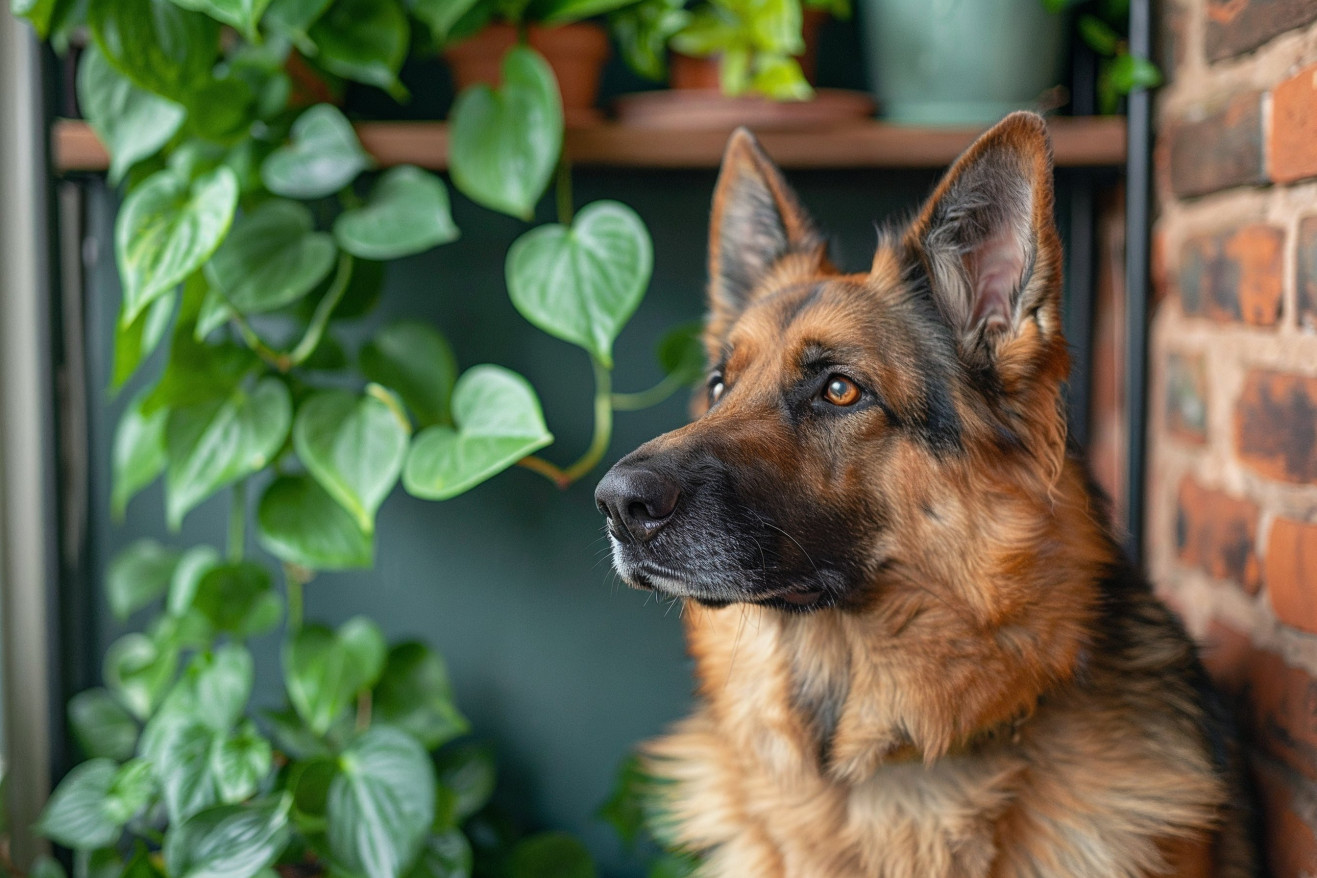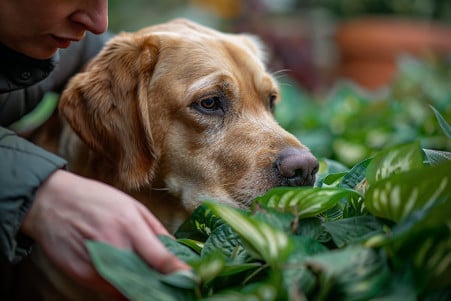Can Dogs Eat Pothos? Here's What Science Says
28 May 2024 • Updated 28 May 2024

Pothos is a common indoor plant with heart-shaped leaves and a trailing growth habit, but it's also potentially toxic to dogs. The reason is that pothos (Epipremnum aureum) contains insoluble calcium oxalate crystals, which can lead to oral irritation, drooling, vomiting, and difficulty swallowing in dogs if they eat the plant.
To help you better understand the dangers and potential consequences of pothos toxicity in dogs, we'll explore the results of research in the fields of veterinary medicine, botany, and plant toxicology. By doing so, we hope to give you a well-rounded understanding of the topic that will help you protect your dogs and create a safe home for them that still includes the beauty of indoor plants.
Are pothos plants toxic to dogs?
Toxic Compounds and How Pothos Poisoning Works
The primary toxic compound in pothos plants is insoluble calcium oxalate crystals found in the leaves and stems. When a dog chews or eats the plant, these sharp crystals can penetrate and irritate the tissues of the mouth, throat, and digestive tract.
This physical irritation and inflammation is responsible for the most common symptoms, including drooling, pawing at the mouth, and vomiting, according to veterinary guidance. In more severe cases, the swelling and irritation can spread to the upper airway, causing breathing problems and even airway obstruction, which is a medical emergency.
While the calcium oxalate crystals are the main issue, other compounds in the plant, such as glycosides and steroidal saponins, may also play a role in the overall toxicity of a large ingestion of the plant by a dog. These compounds can cause further tissue irritation and may even lead to systemic problems if they're absorbed into the bloodstream.
Understanding where pothos toxicity comes from and how it works is important for pet owners so they can understand the variety of symptoms and potential complications that can come from an accidental ingestion. It's important to seek veterinary care right away so the situation can be properly evaluated and the dog can be treated to relieve their symptoms and prevent serious complications.
Signs and Severity of Pothos Poisoning in Dogs
The most common signs of pothos poisoning in dogs are drooling, vomiting, and oral irritation or pawing at the mouth, according to Cuteness. In mild cases, the signs may be limited to gastrointestinal upset and discomfort, and they will go away on their own within 24 to 48 hours.
However, more severe cases can include difficulty swallowing, breathing issues, and swelling of the upper airway, which can be life-threatening, according to The Nature of Home. The severity of the signs depends on the amount of plant material that was ingested and the size of the dog.
If any signs continue or get worse, including lethargy, loss of appetite, or respiratory issues, you should contact a vet right away, according to the JustAnswer forum.
Veterinary Care and Treatment of Pothos Poisoning
If a dog has eaten pothos, immediate veterinary care is needed for proper treatment and observation, according to Greg. The vet may induce vomiting or perform gastric lavage to remove any remaining plant material from the digestive system. The vet may also need to provide supportive care, including fluids, antihistamines, and anti-inflammatory drugs to help with symptoms, says WagWalking.
In cases where the dog is experiencing airway obstruction or respiratory issues, emergency treatments such as endoscopy or surgery may be necessary, according to Greg. Most dogs will make a full recovery with treatment, however, the prognosis is less certain if the dog doesn't receive treatment until after clinical signs have developed or if the dog has ingested a large amount of the plant, according to the Merck Veterinary Manual.
How to Protect Your Pothos Plant From Dogs
To avoid accidental consumption, it's recommended to keep pothos plants out of reach of dogs or opt for pet-friendly options, according to Flora. If you do have pothos, you can use hanging baskets, plant stands, or other barriers to keep them away from dogs. You should also regularly prune and clean up any vines or leaves that have fallen off and could attract dogs to chew or eat the plant, per Binds Bucket List.
You can also provide environmental enrichment, such as toys and scratching posts, to help prevent destructive behavior and keep dogs from exploring your plants, according to Flora. Make sure to be cautious when bringing new plants into your home and research whether they are toxic to pets before you buy them to make sure your home is safe for your pets.
Pothos Toxicity in Other Pets and Pet-Safe Plant Alternatives
In addition to dogs, pothos plants are also toxic to other pets in the household, including cats, rabbits, guinea pigs, and birds. In these animals, ingesting pothos can lead to the same symptoms of oral irritation, excessive drooling, and gastrointestinal upset that dogs experience.
For pet parents who want to bring plants into their homes, there are many non-toxic plant options that they can enjoy, including spider plants, Boston ferns, and Chinese evergreens. However, it’s important to always research the toxicity of any plant before bringing it into the home.
Veterinarians can provide information about the toxicity of specific plants, and the ASPCA's list of toxic and non-toxic plants is a helpful resource for pet parents who want to ensure that the plants they choose are safe. With a little bit of research, pet parents can create a home that’s both beautiful and safe for their furry, feathered, or scaly friends.
Wrapping Up: Understanding the Risks of Pothos for Dogs
Pothos plants are popular houseplants, but they can be dangerous to dogs and other pets if they’re ingested. The insoluble calcium oxalate crystals in the plant cause oral irritation, excessive drooling, vomiting, and, in some cases, airway obstruction. If a pet has ingested pothos, it’s important to get them to a vet as soon as possible.
To keep pets safe, it’s best to avoid growing pothos plants in homes with pets. However, for those who want to keep pothos plants in their homes, there are steps that can be taken to help keep pets safe, including using elevated plant stands or other barriers to keep pets away from the plants. In addition, providing pets with other forms of enrichment and ensuring that they have access to pet-safe plants can help keep them from eating toxic plants.
By learning about the dangers of pothos plants and taking steps to protect pets, pet parents can create a home environment that’s safe for everyone. It’s important to choose plants carefully and to take steps to keep pets away from toxic plants. However, with a little bit of effort, it’s possible to create a home that’s safe and comfortable for everyone, both human and animal.


